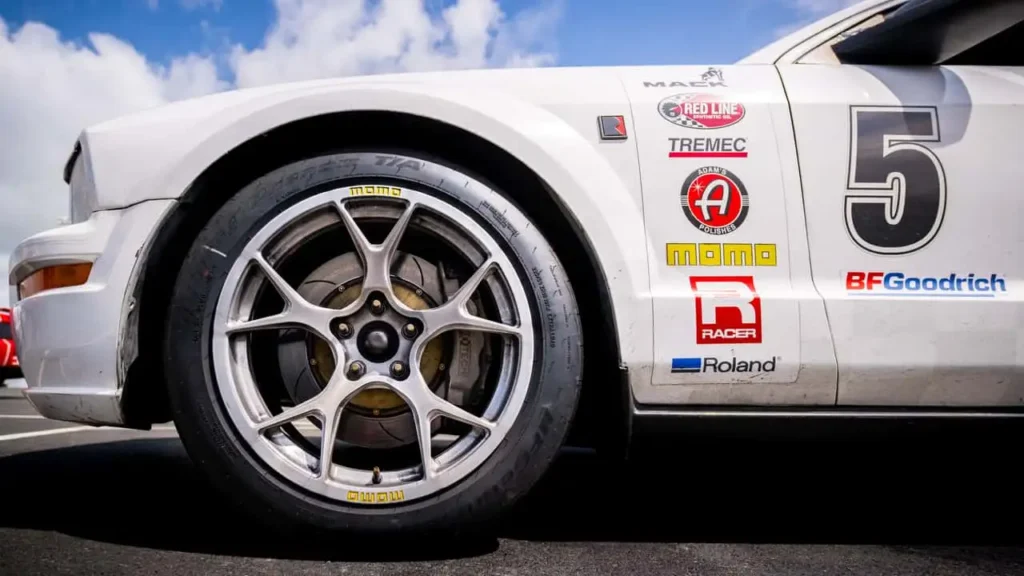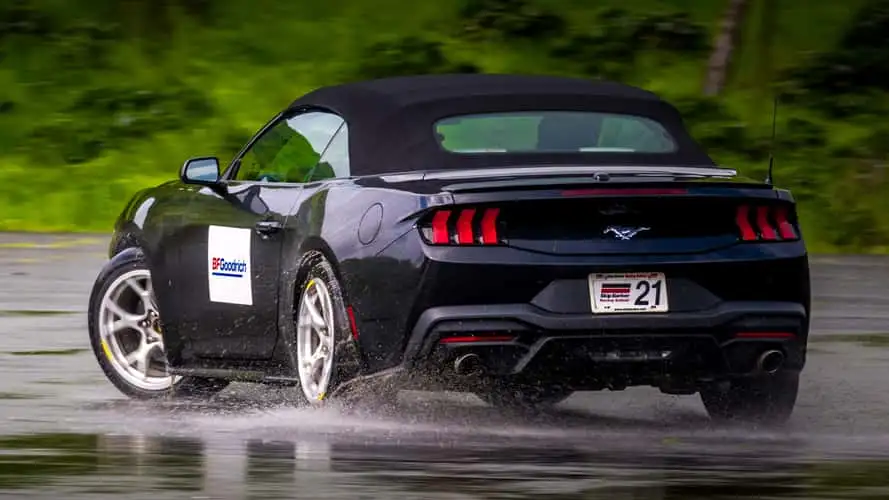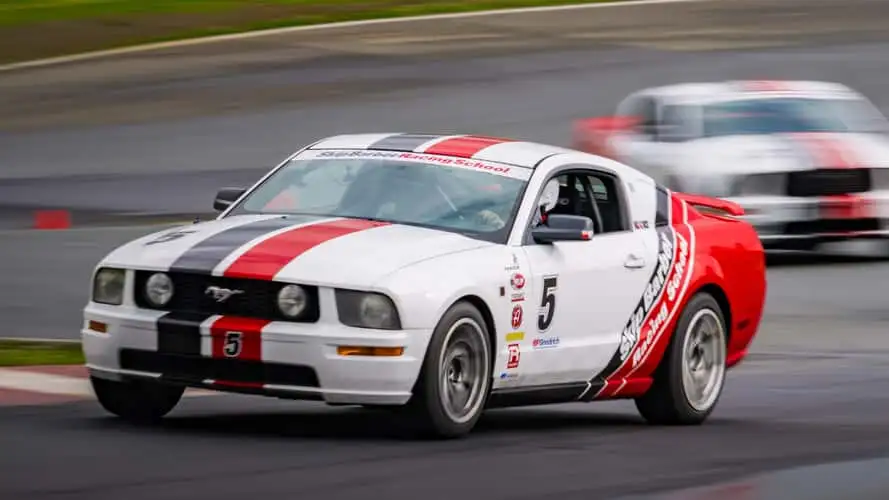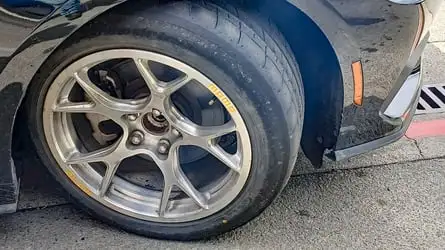Usually, rain on a track day is disappointing. At worst, you watch helplessly as the rain washes out all the sessions. Sheltering beneath a Skip Barber tent at Sonoma Raceway during a particularly aggressive downpour, I wondered whether this two-day event with BGGoodrich would, in fact, be a washout. Instead, it became the perfect opportunity to explore both the wet and dry handling characteristics of the latest G-Force tire from BFGoodrich, called the Phenom T/A.
This tire slots into the Ultra-High Performance summer-only segment, replacing the G-Force Sport Comp 2, which BFGoodrich admits was a bit long in the tooth. Phenom ditches the old directional tread for an asymmetric pattern featuring two distinct regions. The “dry zone” on the outside consists of broad shoulder blocks, while the “wet zone” fills the inner tread with narrower blocks and more lateral grooves.

Speaking of grooves, three wide rain grooves circumnavigate the tire with a smaller fourth positioned close to the outside. After driving Mustang GTs on a soaked track and not hitting anything, I can say the tires are good in the wet. More on that later.

As for the tire compound, BFGoodrich cooks up a silica-infused recipe incorporating nearly 200 ingredients in a proprietary stew. The goal is to create a sticky street-legal tire, but specific attention was given to braking performance in dry and wet conditions. To that end, BFGoodrich says the Phenom outbrakes numerous competitors on wet roads, including the Yokohama Advan Apex V601, Falken Azenis FK510, Hankook Ventus V12 Evo2, and the Firestone Firehawk Indy 500. The fine print, however, advises us that actual on-road results may vary.
What else goes into the Phenom? It’s a W-rated tire with stiff sidewalls that work with the shoulder blocks to aid cornering grip. However, the company also sees these tires as a vital component of the suspension, so some flexibility for on-road comfort is built into the design. Speaking to BFGoodrich reps prior to the track sessions, I was advised to pay particular attention to the progressiveness of the grip in corners. Considering Sonoma Raceway was basically a river for the first half of the day, there was no choice but to be mindful in the twisty bits.
Let’s talk looks and pricing. The Phenom is positioned as a high-performance summer tire, and BFGoodrich didn’t overlook style—its tread pattern and sidewall design are made to stand out. Targeted primarily at the tuner crowd, the Phenom caters to drivers who are just as passionate about track days as they are about showing off their cars at cruise nights or car meets. Pricing depends on the size, but generally ranges from around $140 to $230 per tire. The lineup includes 50 different sizes, starting at 205/55R16 and going up to 245/35R20.
For transparency, I didn’t get a chance to do any head-to-head testing against rival tires. BFGoodrich partnered with the Skip Barber Racing School at Sonoma Raceway, which exclusively uses the Phenom on its fleet of S197 Mustang GT school cars. These Mustangs feature upgraded suspension systems and the essential safety gear for track use, but otherwise stick to their stock setups, including a 4.6-liter V8 engine delivering 320 horsepower and a six-speed manual transmission.
There were also a couple of new EcoBoost Mustangs available for limited testing off-track—one equipped with the Phenoms, the other with Firestone Firehawk Indy 500s. While you could consider it a comparison, the low-speed autocross and skidpad formats didn’t really allow for a definitive evaluation.

So how does the Phenom actually perform? I admit to being a bit timid during the first 20-minute track session. Light-to-moderate rain was falling, the track was soaked, and let’s be honest—these older solid-axle Mustangs have a reputation for crashing in the hands of slightly overzealous drivers. Fortunately, I have an older Mustang at home in the garage, so I wasn’t completely unfamiliar with the wet-weather experience.
And I was impressed with the Phenom’s wet grip. Only once did I get a little squirrely with too much throttle exiting turn 2. Ninety mph approaching turn 7 was a breeze, with no hint of hydroplaning. After a warm-up lap, I felt comfortable pushing a bit harder through Sonoma’s infamous chicane. I was nowhere near the car’s limit, partially because I didn’t want to crash, but mainly because we were all following a Skip Barber pace car that kept everyone in check. Still, after reviewing my telemetry I was surprised to see a few 0.8g corners in very wet conditions. The grip was there. More importantly, I felt comfortable exploring it.
A touch of rain stuck around for the second session, but the skies finally cleared on day two for some dry laps. Unfortunately, we still had pace cars that kept speeds well in check, so honestly, it’s tough to say just how good these tires really are. I was not able to kick the back loose in any corner without deliberate, blatant attempts. Most corners were taken far below the limits of the car and the tires, though I was able to aggressively tackle turn 7 on occasion, getting just a bit of scrub from the left side in the process.

The Phenons definitely have grip, wet or dry. With speeds increasing through the later sessions I managed to pull a full g of lateral acceleration through a few corners. By this time the Skip Barber instructors upgraded to Mustang pace cars, but speeds remained under 100 mph and braking zones were generous. After the sessions, the Phenoms were showing a bit of use but wear was very even.
For someone not interested in having a dedicated set of race tires, I can see these being good for a few autocrosses and the occasional track day amid daily driving duties. Just bear in mind that this is a summer-only tire that doesn’t perform well below 40 degrees, never mind snow. And with its performance focus, BFGoodrich offers no treadwear warranty.
Ironically, I got a better understanding of the Phenom’s strengths off the track in the EcoBoost Mustangs. Instructors turned us loose on wet and dry skid pads to explore understeer and oversteer. It’s part of Skip Barber’s two-day driving school, but for our purposes, it provided a chance to actually get some heat in the tires.

To BFGoodrich’s credit, the Phenoms were reasonably progressive at the limit and didn’t just turn to slippery goo when hot. It was easy to feel understeer in the Mustang’s wheel, and when the back stepped out, the loss of grip was gradual. By comparison, the Firestones felt a bit grippier at first but went away rather suddenly. Sadly, I sacrificed an orange autocross cone to uncover this truth. All in the name of science, right?
So, is the Phenom a worthy tire in the UHP segment? It has plenty of dry grip, and I was properly impressed with how it held in the rain. It also seems to handle heat well, though I’d want a bit more track time to really suss that out. Compared to the Firestone Firehawk Indy 500, it’s definitely easier to manage when you exceed its limits, but prior to that point, I think the Firehawk had a better bite on dry ground.
